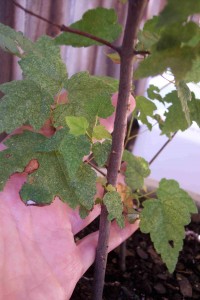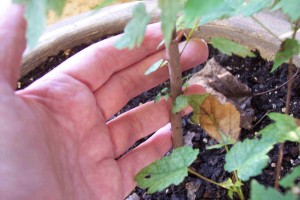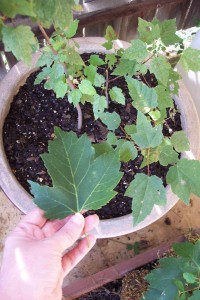I’ve been fascinated by bonsai trees for over twenty years. I started out buying pre-made bonsai from places like Sam’s Club or Target. Invariably, they all died. After reading a few bonsai books, I understood why and decided to follow the advice of those same books — grow and train my own. I placed seeds in the freezer for a few weeks, like the books said, then planted them in pots at the precise depth the books said — and watched them fail to sprout. I bought junipers, box elders, and other evergreen shrubs from places like Lowes and Home Depot, carefully transferred them to bonsai pots, trimmed them, watered them, did everything the books told me to do. And, invariably, they all died. Well, except for one that I made as a gift for a co-worker’s husband which lasted at least until I took a job with a different company in a different state.
I suspected my bad luck with bonsai was the work of my lifelong black thumb that prevents me from keeping any potted plant more demanding than pothos alive. Still, I wasn’t ready to give up, so each year I wandered the aisles of my local home improvement store’s garden section, picking out promising-looking shrubs.
One spring after we moved back to North Carolina from Ohio, I was going through the yard yanking up the hundreds of little oaks and maples that had once again sprouted all over the place when an idea hit me: plant these as bonsai. Obviously the temperature and amount of sun and water were perfect for them, so they might be able to handle the strain.
I planted a few promising specimens in plastic buckets. And, as always, they died.
When the trees around our house dropped their annual deluge of acorns and “helicopter” seeds that year, they blanketed those plastic buckets with the things. Which I ignored because I don’t leave the house when it’s less than 60 degrees outside. But as the weather warmed up, those little seeds, like the thousands scattered across the yard, decided this was a place they could grow. So they did, and I found myself greeted by lots of little green shoots in those buckets by the time I ventured outside.
They seemed to be doing just fine on their own, so I vowed to ignore them. I didn’t worry about watering them. I didn’t try to move them so they could get sun. I just left them where they were by the front porch steps in those ugly buckets. My only concessions to trying to keep them alive were to thin them out once or twice and to tell my husband and landlord that the buckets weren’t garbage and were to be left alone.
Three years, I told myself. Don’t do anything with them for three years. At minimum two.
And they survived.

The smaller, wooden planter only has one tree, and some very sad looking moss and ornamental grass. Weeds, too, which I pull from time to time.
Each fall their leaves would turn red and gold, like their larger cousins around them, and then fall off. Each winter I’d hold my breath, staring at what looked like nothing more than sticks in those planters, and each spring I’d creep out to check them, wanting to whoop for joy when I saw little shoots of green.
I eventually transplanted them from the buckets to regular pots. Some died, but several survived. Three large planters with three or four each in them, plus a smaller wooden planter with two. I tried tossing other seeds in the buckets, things I found around the yard, but nothing else sprouted.
This spring I lost all the trees in two of the larger planters. Whether it was lack of water, or lack of drainage — I never could get holes drilled in those two — or damage from bugs that like to munch the leaves or squirrels that were determined that these were trees and therefore must have nuts around them somewhere, I don’t know. But when everything around them had started to leaf out and those still looked like sticks in dirt, I had to admit they were gone.
But the two trees in the last large planter, and in the small wooden one, they were just fine.
They didn’t really look like bonsai, though. A bonsai is a miniaturized tree. It’s not just short; its leaves are supposed to be miniaturized, too. These trees still had full-sized leaves. What’s more, they were getting tall — really tall — but staying very skinny. So I decided I was going to have to bite the bullet and do something I’d dreaded from the start.
I was going to have to trim them.
Those of you who grow roses or other flowers probably understand the idea behind this. Cut back the first few blooms each year, and the plant will produce lots of blooms. It’ll get bushier, too. Leave those first few blooms, and they’ll be about all you get. The idea with trimming these trees was similar — cut the tree shorter so it would spend more energy growing a thicker trunk and producing more and smaller leaves. If I didn’t cut the tree back, it would keep growing taller and producing just a few normal-sized leaves.
The worrisome bit was that each tree only had a handful of leaves. So I had to cut the tree shorter but still leave enough leaves for it to survive. Dicey, to say the least. In the end, most of the trees ended up with only a couple leaves left. Worrisome, indeed. Not to mention that any time you cut a tree, you’re causing stress that can kill it. I was sure I’d be yanking dead, stick-like things out of the planters within a month.
But then tiny bits of green popped up along the branches, and in the crux where the branches met the trunk. And no sooner had those leaves unfurled than more bits of green sprouted. A profusion of tiny leaves.
The move to the new house has been hard on the trees. We get almost full sun all day here, where the old house got almost full shade. It took less than an hour for every plant in all my planters to get burned the first day we had them here. The ornamental grass I put in the wooden planter for decoration and the moss I added to help retain moisture are brown and mostly dead. We’ve got them under the carport now, but you can tell from the pictures that the leaves aren’t the bright, healthy green that they used to be.
Still, every day when I check them I see more bits of green. More little leaves. And so I water them, or don’t, and mostly leave them alone and hope those leaves will turn red and gold this autumn, and fall off like the trees around them, and sprout green again in the spring.








